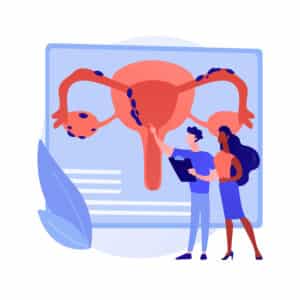March is Endometriosis Awareness Month. In this Blog we will speak about endometriosis, which affects approximately 10% of women and girls of reproductive age worldwide. It is a silent, disabling disease that has a lot of impact on the quality of life of women who suffer from it. Currently, specialists and associations fight to make this disease visible and offer quality information. If you are suffering from abdominal pain and you recognize yourself in the story below, don´t hesitate to start a conversation with your doctor or contact our Telemedicine service through the portal. As we all know that being far from home can make it feel more difficult to start the conversation about these types of complaints. The doctors of Teladoc Health can support you with your questions and make sure you receive the correct information.
What is it
It is a non-contagious disease that consists of the benign growth of endometrial tissue (the one that lines the inside of the womb) outside the uterus, reaching organs such as the ovaries, pelvis, fallopian tubes and intestines.
This misplaced endometrial tissue continues to behave as it normally would: it thickens, breaks down, and bleeds with each menstrual cycle. Since this tissue that is out of its usual place has no way out of the body, it becomes trapped (unlike the endometrium, which is expelled with each menstruation). This situation can irritate surrounding tissues and develop scar tissue and adhesions (abnormal bands of fibrous tissue that can cause pelvic tissues and organs to attach to each other).

Despite its frequency, we do not know what causes it, although there are several theories that could explain its appearance and it is known that it has a significant hereditary burden.
Is it a modern disease?
Probably not. Since ancient times, medical texts describe women with pelvic pain, sterility and menstrual disorders. Previously, these disorders were grouped under the name of “asphyxia of the womb”, making it difficult to distinguish between endometriosis and other gynecological diseases.
- The first description of a case of endometriosis is from 1690, by the German physician Daniel Shroen. However, in the following centuries, women with symptoms of endometriosis (menstrual cramps and infertility) were diagnosed with “hysteria.”
- In 1860, Austrian physician, pathologist, philosopher, and politician Carl Von Rokitansky published a detailed description of endometriosis, identifying the disease as clusters of endometrial tissue.
- The term endometriosis was coined in 1927, when gynecologist John A. Sampson cited it in his publications and cited retrograde menstruation as a possible cause.
- It was in 2013 when the first guide to inform and raise awareness among the population was created.
Symptoms of endometriosis
Endometriosis is a very particular entity, which affects women who suffer from it in a very different way. Some may have their quality of life affected and others may be asymptomatic.
The intensity of pain is not necessarily an indicator of the severity of endometriosis. Some women with mild endometriosis have severe pain, while others with advanced endometriosis have little or no pain.
Sometimes this disease is confused with other conditions that also cause pelvic pain, such as pelvic inflammatory disease or ovarian cysts.
The symptoms of endometriosis would be:
- Dysmenorrhea or menstrual pain: very painful periods, intense pain in the lower back that radiates to the abdomen. This is what we call secondary dysmenorrhea. It is usually the first manifestation of endometriosis. In addition, it is a pain that increases over time.
- Dyspareemia: presence of pain during or after sexual intercourse. Vaginal penetration can press on an area affected by endometriosis: ovaries, vaginal roof and uterosacral ligaments.
- Spotting: Some women are spotting (losing small amount of blood) that are not related to menstruation.
- Difficulty urinating and/or defecation
- Reproductive problems: about 30-40% of affected women cannot become pregnant, they have infertility, this is the most frequent way to diagnose the disease.
- Menorrhagia: excessive bleeding during menstruation.
- Digestive symptoms: episodes of diarrhea and constipation, gas or nausea that can be mistaken for an irritable bowel.
- Miscarriages: Women with endometriosis may have an increased risk of miscarriage, which decreases once the disease is treated and corrected.
Endometriosis usually develops several years after menstruation begins. Signs and symptoms of endometriosis cease during pregnancy and end permanently with menopause, unless estrogen is being taken.
When to see your doctor

It should be consulted whenever its presence is suspected, and the symptoms described are suffered. Endometriosis is difficult to treat, so early diagnosis and multidisciplinary treatment, as well as a clear understanding of what happens to you, can promote symptom control.
Latest research: endometriosis and heart attacks in young women
According to a recent study published in the journal of Brigham and women’s hospital, linked to Harvard University, endometriosis could be the cause of many heart attacks suffered today by very young women, under 40 years.
Causes
The cause of endometriosis is still unknown, but attempts have been made to postulate different theories to explain the growth of the endometrium outside its usual location.
- The existence of families where grandmothers, mothers and granddaughters suffer from this disorder reinforces the idea of its hereditary character.
- Retrograde menstruation: This theory proposes that menstrual blood containing endometrial cells flows abnormally down the fallopian tubes into the pelvic cavity, rather than its normal path to the outside of the body. These cells attach to other organs causing the typical discomfort of endometriosis.
- Transformation of peritoneal cells: this is known as the “theory of induction”. It seems that immune factors and hormones favour the transformation of peritoneal cells (cells that line the inside of the abdomen) into endometrial cells.
- Transformation of embryonic cells: estrogens can transform embryonic cells (cells in the early stages of development) into endometrial cells. This would occur during puberty.
- Implantation in the scar from surgery: After surgery, such as a cesarean section or hysterectomy (removal of the uterus), endometrial cells can” leak” during the surgical cut and implant outside the uterus.
- Transport of endometrial cells: The lymphatic system can transport endometrial cells to all parts of the body.
- Immune system disorder: it is postulated that an alteration of the immune system prevents the body from recognizing and destroying endometrial tissue that grows outside the uterus.
It seems that pregnancy exerts a protective effect on the development of future endometriosis. The ovaries remain at rest during pregnancy, without secretion of female hormones, which seems to have a protective effect.
Risk factors
There are several factors that may be at increased risk for developing endometriosis:
- Not having given birth.
- Very early onset of menarche (first menstruation).
- Short menstrual cycles of less than 27 days.
- High estrogen levels.
- Having a low body mass index.
- Consuming alcohol.
- Having a family history with endometriosis.
- Uterine anatomical abnormalities.
Complications of endometriosis
The main complications are:
- Infertility: affects one-third of women with endometriosis.
- Ovarian cysts: When endometriosis affects the ovaries, cysts we call endometriomas can form.
- Ovarian cancer: Women with endometriosis are more predisposed to this type of cancer.
How it is diagnosed
Ultrasound is used to assess the reproductive organs, being able to detect cysts or endometriomas. The definitive diagnosis is given by laparoscopy. This invasive procedure is diagnostic (the surgeon explores the entire interior of the abdominal cavity) and therapeutic, since, during it, as much endometriosis as possible can be removed.
Treatment
Specialists recommend taking care of the physical and emotional health of women suffering from endometriosis. A balanced diet and the practice of physical exercise is the mainstay of treatment of any condition.
The goals of treatment are:
- Pain relief and associated symptoms.
- Prevent progression of injuries.
- Preserve or restore reproductive function.
The specific treatment for endometriosis consists of medication or surgery, but none definitively cure the disease.
Analgesics
It is the first therapeutic step to control pain during menstruation. It is a symptomatic treatment of pain produced by endometriotic lesions and possible existing adhesions.
Hormonal drug treatment
The rise and fall of hormones during the menstrual cycle causes endometrial implants to thicken, break down, and bleed. Hormonal drugs can slow the growth of endometrial tissue and prevent new implants.
Treatments used to treat endometriosis include:
- Contraceptives: These are combinations of estrogen and progesterone that relieve the symptoms of mild endometriosis.
- Progestogens: decrease the levels of estrogen, which are the main stimulants of the growth of endometriosis.
- GnRh analogues: decrease the function of the ovary and cause reversible artificial menopause. It is a last resort when other treatments don’t work, as they have many side effects similar to menopause.
- Androgens: also decrease ovarian function and cause virilizing side effects and those associated with menopause.
Surgical treatment
It is the most effective treatment and the one with the highest success rate. It is performed by laparoscopy, which is a minimally invasive surgery that allows the surgeon to assess the entire abdominal cavity.
The main objective of this technique is to eliminate all visible endometriosis preserving and restoring, if necessary, reproductive function (conservative surgery) although hysterectomies (removal of the uterus) can also be performed in more severe cases.
On the occasion of World Endometriosis Day, we have gathered the testimony of Léa, a collaborator suffering from endometriosis who tells us about her experience with the disease:
My endometriosis was diagnosed when I was 22 years old. After 8 years of medical wandering, medical specialists finally managed to put words to my ailments.
The diagnosis made it possible to use more appropriate treatments to limit the pain (combined pills, continuous use, hormonal IUD, etc., each of which has its own side effects and risks specific to each patient). I was also able to undergo surgery to discover the extent of the disease, its damage and to remove certain lesions in order to try to reduce the impact of the disease on my life and limit the risks of infertility.
Beyond these medical aspects, my diagnosis was a real relief, it allowed me to realize that the pain was not “in my head” but very real, to understand that I was not alone, and that many women live or learn to live with this disease.
But contrary to popular belief, endometriosis is generally not just about painful periods and can have a major impact on the patient’s personal and professional life, as well as on the people around her. Between the pain, chronic fatigue, digestive and urinary problems, the disease is present in my daily life and I have to learn to live with it rather than fight against it.
But fortunately, medicine is progressing, diagnoses are becoming more and more established, more and more awareness is being raised, this disease is gradually emerging from its shadow and becoming less and less taboo. For all these reasons, I believe that it is important to raise awareness and talk about this disease in order to accompany the women concerned and their families in their journey towards the diagnosis, with good medical and psychological support, adapted treatments and to avoid that they feel alone, powerless and misunderstood in front of their pain.
Teladoc Health offers through Foyer Global Health 24/7/365 access to an online team of doctors. If you would like to receive medical advice, click on the link and visit the e-care portal. Register now and request any of the services free of charge, at any time and place and without the hassle of making a claim.


